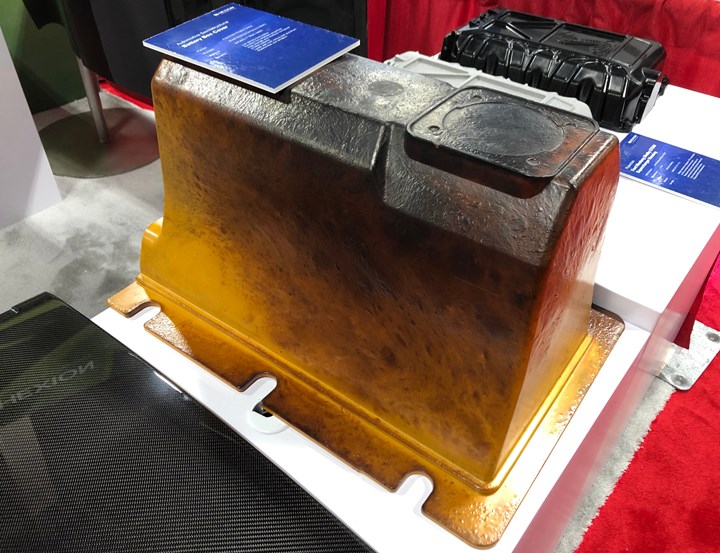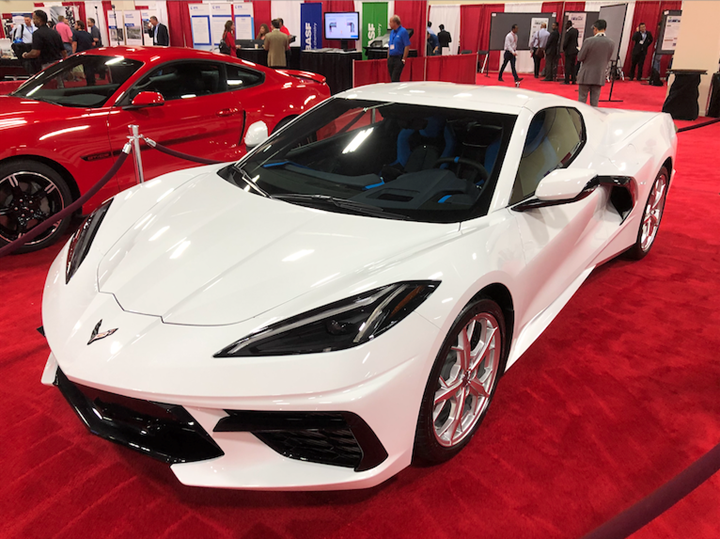Can the automotive industry turn to face the change?
SPE ACCE speakers speculate about how changing consumer behaviors might shape the automotive industry.
Share

Cynthia Flanigan, chief engineer of Vehicle Research & Technology for Ford Motor Co. discusses “Driving Automotive Materials Forward.” Photo | Mark Richardson, Society of Plastics Engineers
The Society of Plastics Engineers (SPE, Bethel, Conn., U.S.) held its 19th annual Automotive Composites Conference & Exhibition (ACCE) in Novi, Michigan, Sept. 4-6. The theme of the conference was “Composites — Forming the Future of Transportation Worldwide,” and much of the programming reflected a growing interest from transportation OEMs in the role composites technologies can play in next-generation mobility.
The conference kicked off with a keynote from Cynthia Flanigan, chief engineer of Vehicle Research & Technology for Ford Motor Co. (Dearborne, Mich., U.S.), who discussed “Driving Automotive Materials Forward.” The keynote speculated about potential changes in the way society uses vehicles. Global population and overcrowding of urban areas are pushing us toward a need to reshape our modes of transportation and approach mobility in a very different manner than society has in the past. Many theorize that we are moving from a society based on individual vehicle ownership to one where carsharing and e-mobility could represent the lion’s share of the automotive market. Flanigan focused on five key areas that are driving change in the industry: sustainability, emerging materials, additive manufacturing, advanced processes and design, and artificial intelligence.
From reducing ocean plastic and atmospheric CO2 to the use of blockchain technology to link data, track materials and enable sorting and recycling, to looking to nature for inspiration in new materials, Flanigan spoke of sustainability and responsibility to the environment as a key driver of technology trends. She spoke of emerging materials as an enabler for the future, pointing to materials such as graphene and aerogels, contributing to lightweighting and improving the consumer experience through noise dampening. She spoke of advances in additive manufacturing and the technology’s role in the composites space, offering the opportunity for higher throughput and advancements in processing. She summed up the potential of advanced processes, design and artificial intelligence saying, “We at the cusp of [being able] to utilize enabling technologies that are blooming.”
A featured talk from Clay Maranville of Ford Motor Co., echoed many of the ideas from Flanigan’s keynote with a focus on automotive interiors. Maranville looked at megatrends affecting mobility from consumer behavior such as carsharing to such industry trends as additive manufacturing, generative design, embedded sensors, and blockchain. He indicated a shift in design thinking is happening and that automotive interior design is becoming increasingly focused on the consumer experience and the ways that is evolving.

This flame retardant battery box cover constructed of phenolic SMC from Hexion retains 60-70% of its material properties after aggressive fire testing. CW Photo | Scott Francis
The conference featured a prominent programming track on sustainability, which included 11 papers on topics relating to sustainability. There were numerous presentations on technologies aimed at enabling electric vehicles. Sheet molding compounds (SMCs) aimed at enabling battery systems in electric vehicles were featured heavily at the show. Pritesh Patel of Evonik (Parsippany, N.J., U.S.) discussed an epoxy resin-based SMC battery case for electro-mobility vehicles. Ian Swentak of Hexion (Columbus, Ohio, U.S.) showcased a phenolic resin SMC-based battery box optimized for fire resistance.

Gulay Sherhatkulu, senior vice president, Performance Materials North America, BASF Corp. CW Photo | Scott Francis
Gulay Sherhatkulu, senior vice president, Performance Materials North America, BASF Corp. (Wyandotte, Mich., U.S.) delivered the conference’s second keynote, painting a picture of a new generation of consumers largely comprised of a digital natives who are less concerned with ownership and more concerned with connectivity, comfort, convenience, environmental concerns and sustainability. She spoke of a value chain shifting from a focus on the end consumer to fleet-based transportation companies, and with this fundamental shift, changes is R&D and design thinking, and a need to get products to market more rapidly.

Bamboo honeycomb panel from BASF. CW Photo | Scott Francis
Elias Shakour, project leader, Composites Technologies of BASF showcased an example of developing structural natural fiber parts using a spray transfer molding (STM) process, yielding a honeycomb panel constructed of bamboo fiber and sustainable polyurethane resin system.
Just how drastically the landscape of automotive sector will change remains to be seen, but it’s clear that the industry is exploring what changing consumer behavior will mean for the future of automotive transportation. Growing populations and traffic congestion indicate that the way we travel as a society will have to evolve. Several ideas bandied about at SPE ACCE revolved around carsharing and included modular component designs to make parts easy to replace, materials with low noise vibration and harshness (NVH), materials with antibacterial qualities — all of which could mean a large role for composite materials.

The composites-intensive 2020 Chevrolet Corvette Stingray CW Photo | Scott Francis
At the same time, many people see individual car ownership as part of our identity. The final keynote at SPE ACCE was about the composites on the new Chevrolet Corvette Stingray, with its luxury cockpit that wraps the driver in an immersive console. Plenty of composites were employed in the new ‘Vette from primary body structural panels to underbody structural panels to class-A composite body panels to air ducts to its carbon fiber pultruded rear bumper assembly. But the mindset is obviously completely different. For many drivers, a personal connection with the car remains, and it’s a safe bet that carmakers will continue to capitalize on that connection as long as they can.
So, the questions remain. How quickly will large groups of the population transition to carsharing and new solutions for mobility? How many people will cling to their cars? What will the auto industry look like in the coming decades? Only time will tell.
Related Content
TPI manufactures all-composite Kenworth SuperTruck 2 cab
Class 8 diesel truck, now with a 20% lighter cab, achieves 136% freight efficiency improvement.
Read MoreInfinite Composites: Type V tanks for space, hydrogen, automotive and more
After a decade of proving its linerless, weight-saving composite tanks with NASA and more than 30 aerospace companies, this CryoSphere pioneer is scaling for growth in commercial space and sustainable transportation on Earth.
Read MoreParis Air Show 2023 highlights
The Paris Air Show, one of the largest aerospace trade shows in the world, returned for the first time since 2019 and proved that the global aviation industry industry is very much alive and kicking.
Read MoreRecycling end-of-life composite parts: New methods, markets
From infrastructure solutions to consumer products, Polish recycler Anmet and Netherlands-based researchers are developing new methods for repurposing wind turbine blades and other composite parts.
Read MoreRead Next
Developing bonded composite repair for ships, offshore units
Bureau Veritas and industry partners issue guidelines and pave the way for certification via StrengthBond Offshore project.
Read MoreAll-recycled, needle-punched nonwoven CFRP slashes carbon footprint of Formula 2 seat
Dallara and Tenowo collaborate to produce a race-ready Formula 2 seat using recycled carbon fiber, reducing CO2 emissions by 97.5% compared to virgin materials.
Read MorePlant tour: Daher Shap’in TechCenter and composites production plant, Saint-Aignan-de-Grandlieu, France
Co-located R&D and production advance OOA thermosets, thermoplastics, welding, recycling and digital technologies for faster processing and certification of lighter, more sustainable composites.
Read More












.jpg;maxWidth=300;quality=90)









